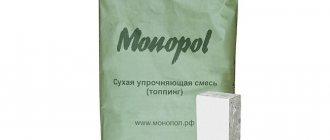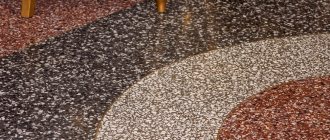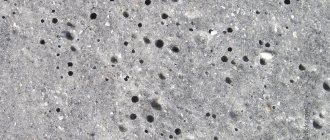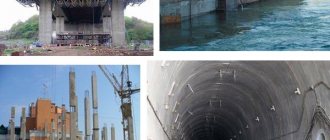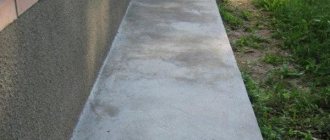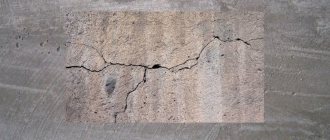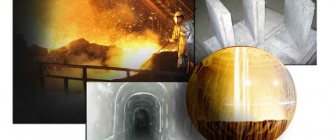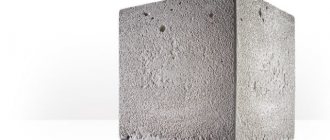When constructing structures made of reinforced concrete, an important factor that must be observed is the fire protection of concrete. During a fire, structural elements begin to heat up quickly, microcracks form and strength decreases. To protect concrete from fire, heat-insulating materials are used to ensure slow heating of the walls and base, such as plaster, cladding, mineral boards, screens and intumescent fire-retardant paints. Treated surfaces increase the resistance limit to 240 minutes.
Our services for fire protection of concrete and reinforced concrete structures
We carry out fire protection of all types of reinforced concrete structures using modern technology!
We offer the following work:
- use of slab or sheet cladding,
- installation of protective screens,
- plastering (or applying an additional layer of concrete) to the surface,
- painting with special fire-retardant paints,
- technical selection of the required sections of elements.
We calculate fire resistance based on the type, grade, moisture content of concrete, reinforcement thickness, geometry of supports and floors, load limit and designed fire protection thickness. And depending on these indicators, we select the best option - plaster, paint, sheet or roll material, etc.
The TechStroyGarant company offers fire protection services for concrete and reinforced concrete structures in Moscow and the Moscow region
Our fire protection work, carried out at a high level, provides long-term fire protection (from 120 minutes) for concrete and reinforced concrete structures
Always during or after a fire, concrete and reinforcing elements quickly heat up, as a result of which it loses its integrity.
For this reason, fire protection of reinforced concrete structures is of great importance - it ensures complete safety of the structure from the consequences of a fire and minimizes the cost of its restoration.
Thanks to the work of our specialists, you will reduce the possibility of fires to a minimum.
We have already protected more than 70 objects and guarantee increased durability of load-bearing structures under direct exposure to fire and high temperatures
Call 8 (495) 150-5-987 and consult for free!
We test the effectiveness of the chosen protection in laboratory conditions: we heat a concrete fragment covered with fireproof material to temperatures comparable to those in a fire.
We protect any buildings from fire: those under construction (at the design stage), recently built or in operation.
For small volumes of work, in order not to disturb the geometric shapes of the building surfaces, we are ready to apply fire retardant materials using hand tools.
For large volumes, plastering of protected structures is carried out using the wet shotcrete method, making it possible to create fire-retardant coatings that accurately replicate the shape of the building structure being protected.
Methods of preparation
Methods for preparing protected surfaces of reinforced concrete elements of objects, components of fire-retardant coatings, combined types of primers, finishing coatings, as well as work conditions; drying periods for each layer; the required total thickness of the fire retardant coating is indicated in the accompanying technical documentation from the manufacturer, which is necessarily attached to each batch of commercial products along with a fire safety certificate.
Sometimes, when designing and constructing construction projects using reinforced concrete structures that do not provide the required fire resistance limit, combined coatings are used that combine paint and varnish materials and structural fire protection.
According to the requirements of the norms and fire safety rules, all building structures that have undergone fire-retardant cladding and treatment must always be available for inspection and diagnostics; current or planned repairs, replacement of damaged areas.
Prices for fire protection of reinforced concrete
We understand that the customer should under no circumstances refuse fire protection because of the high price, therefore we try to offer affordable prices for fire protection of reinforced concrete structures.
| Fire resistance limit | Price |
| R30 | from 440 rub/m2 |
| R45 | from 540 rub/m2 |
| R60 | from 790 rub/m2 |
| R90 | from 1,000 rub/m2 |
| Protection with plaster compounds | from 800 rub/m2 |
*R - loss of bearing capacity after a specified number of minutes.
The cost of installing fire protection is affected by:
- features of the object - purpose, geometry, presence of problem areas, grade of concrete, type of reinforcement, etc.;
- surface condition – wear, need for preliminary cleaning;
- remoteness of the object – the delivery price depends on it;
- volume of work and its complexity;
- required fire protection limit.
Many of these factors influence the choice of material, which is the largest component of the price. In addition: we use lightweight materials, but in some cases a reinforcing frame is still required. Installation work is also included in the total cost.
is a certified dealer of the best domestic and foreign manufacturers of fireproof materials.
Pirilaks-Lux
Price: 316 rub. Fire-retardant impregnation with an enhanced antiseptic effect for wood biopyren "Pirilax-Lux" is used for outdoor work. It has a wood fire hazard class of KM1. It is used for antiseptic purposes as protection of wood from mold fungi and parasitic insects (termites, wood-boring beetles). As a fire retardant, the impregnation in question provides increased fire hazard indicators for wood G1, RP1, B1, D2, T2. More details Quick order Add to cart
Photos on fire protection
Fire protection at the Skolkovo Tambov Innovation School
In a short time, TechStroyGarant specialists completed a large amount of fire protection for load-bearing metal structures of the Skolkovo-Tambov Educational Complex. This is a school with 2,425 places and 97 classes.
Read more >>
Fire retardant and anti-corrosion treatment in the elite residential complex Polyanka 44
Fire protection of load-bearing metal structures and anti-corrosion treatment of the construction site of a residential complex with an underground parking lot “Polyanka 44” has been completed. The reconstruction of the residential complex is being carried out by a large general contractor "CODEST". The most modern and reliable fireproof materials Promat were used.
Read more >>
Fire protection of metal structures of GAZPROM Boiler House in Tikhvin
Work was carried out to bring the fire resistance limits of the metal structures of the Boiler House and Administration Buildings to the required level by applying the fire retardant composition “Terma” and the foil fire retardant material “Bison” for metal structures with a total area of 5953.39. The VMP anti-corrosion system is used.
Read more >>
Fire protection of wooden structures in the Serebryany Bor complex in the Klinsky district
Insulation of air ducts Fire protection of air ducts Fire protection of metal floor beams Structural fire protection of metal structures
TekhStroyGarant carried out fire protection of wooden structures in the Sports and Recreation Complex (PHC) and Congress. A large volume of laminated wood structures were treated with fire retardant compounds from the manufacturer NORT, which were coated with fire retardant varnish.
Read more >>
Fire protection and anti-corrosion treatment of non-residential premises of the Zvezda film studio
"TehStroyGarant" carried out fire protection and anti-corrosion treatment of load-bearing metal structures and engineering systems in the premises of the TV and film studio of the Zvezda TV channel with a total area of 2421.9 sq.m. The work was carried out in difficult access conditions.
Read more >>
Anti-corrosion treatment in the Boiler House on the territory of the military-patriotic park in Kubinka
We completed anti-corrosion treatment of a total area of 3000 m of the boiler room for the heat supply system of the Military-Patriotic Park of Culture and Recreation of the RF Armed Forces “PATRIOT” in the city of Kubinka, Moscow region.
Read more >>
VIEW ALL PROPERTIES
Degrees and limits
(buildings, structures, structures and fire compartments)
| The degree of fire resistance of buildings, structures, structures and fire compartments | Load-bearing walls, columns and other load-bearing elements | External curtain walls | Interfloor ceilings (including attics and above basements) | Building structures of roofless roofs | Building structures of staircases | ||
| flooring (including with insulation) | trusses, beams, purlins | interior walls | flights and landings of stairs | ||||
| I | R 120 | E 30 | REI 60 | RE 30 | R 30 | REI 120 | R 60 |
| II | R 90 | E 15 | REI 45 | RE 15 | R 15 | REI 90 | R 60 |
| III | R 45 | E 15 | REI 45 | RE 15 | R 15 | REI 60 | R 45 |
| IV | R 15 | E 15 | REI 15 | RE 15 | R 15 | REI 45 | R 15 |
| V | not standardized | not standardized | not standardized | not standardized | not standardized | not standardized | not standardized |
How to order fire protection for concrete structures from our company
- You can order fire protection work in Moscow or another region by phone or on the website.
- Our specialist accepts the application and discusses with you the details of ensuring the security of the facility.
- We coordinate with you a visit to the site and examine the scope of work: we select a fire protection method and materials, draw up a plan, determine the deadlines, and agree on the estimate.
- We clean, degrease, level and prime surfaces, preparing them for the application of paints or compounds.
- We apply protective coatings and install fireproof screens.
- We hand over the work of the fire laboratory, after which you receive a certificate of completion, a license from the Ministry of Emergency Situations, a certificate for the fire resistance of materials, and a conclusion from a fire laboratory expert.
- We monitor the quality of fire-resistant coatings annually.
You can obtain more detailed information about the fire protection of concrete and reinforced concrete structures by calling us at 8 (495) 150-5-987 or through the feedback form.
Heat-resistant concrete
The data in the table refers to ordinary concrete. However, as a result of scientific and practical research, the possibility of creating heat-resistant concrete based on Portland cement, which is capable of withstanding temperatures of 1100 degrees and even higher, was discovered.
To do this, alumina-silica or finely ground silica additives are introduced into the material, which bind calcium hydroxide, which is released as a result of cement hydration.
In addition, heat-resistant and fire-resistant materials are used as fillers, such as:
- Brick crushed stone;
- Blast furnace slag;
- Tuff;
- Chamotte;
- Andesite;
- Basalt;
- Chromium iron ore.
Basalt crushed stone
The maximum temperature that such concrete can withstand depends on the fillers. For example, when using fireclay, the maximum temperature is 1100-1200 degrees Celsius. If the structure will not be heated above 700 degrees, broken clay bricks or blast furnace slag can be used as a filler.
Thus, you can even prepare heat-resistant concrete with your own hands at a construction site.
Advice! After the construction of reinforced concrete structures, there is often a need for their mechanical processing. In this case, special equipment with diamond nozzles is used. For example, builders often perform diamond drilling of holes in concrete, as well as cutting reinforced concrete with diamond wheels.
Reinforced concrete structures after a fire
Consequences of fire on reinforced concrete structures
Concrete does not burn, reinforced concrete structure (concrete + metal reinforcement) also does not burn and does not support combustion. It may seem that in a fire in a concrete building, only the finishing and interior are damaged. But this is a big mistake. Four factors that cause catastrophic consequences in a concrete structure during a fire:
- deformation and violation of the structure of concrete. Any material has its own temperature limit. This applies to both the concrete itself and the steel rods with which it is reinforced. Damage to the structure leads to loss of load-bearing capacity, and this can lead to the collapse of the building;
- water in the structure. Like any porous material, concrete contains some amount of moisture. When exposed to heat, it boils, expands and produces an explosive effect. The wetter the concrete, the faster this happens. In raw material - after 5-20 minutes, and the amplitude of the scattering of fragments during an “explosion” reaches several meters;
- Fire extinguishing water, which is present in any building in use, has a negative effect when used: due to the temperature contrast, the structure cracks;
- expansion joints between panels in buildings are filled with sealants that burn and melt. As a result, the joint is exposed, and smoke, flame, and oxygen spread through it to maintain combustion. Once the fire is over, this joint is no longer functional and must be resealed. Otherwise, it is susceptible to atmospheric influences, which changes the microclimate inside the building and again the concrete suffers.
That is why fire protection of concrete and reinforced concrete structures is necessary.
Our licenses
License No. 50-B/00378
SRO extract N0000627
More details
Why does concrete require additional protection?
Under the influence of fire, the reinforcement that permeates the concrete structure begins to expand and melt, which leads to changes in the linear size of the structure itself and its shape. Water, which is part of the concrete itself, provokes an explosion of the material when heated. During the extinguishing process, water enters the elements heated by the flame, which provokes the formation of chips, cracks, and exposure of the reinforcement.
Any concrete structure contains reinforcement
Expansion joints in the joints between concrete structures are sealed with flammable polymer during the construction process. Therefore, in the event of a fire, these areas are the first to be affected by the fire.
Fire protection allows you to increase the time from the start of a fire to damage to concrete, as well as reduce the amount of area over which the flame spreads.
Requirements for fire protection of concrete structures in accordance with SNiP and GOST
The fire resistance of individual structures and buildings as a whole has a numerical and alphabetic expression. The numbers indicate the number of minutes during which the structure resists flame and thermal effects before critical conditions occur. There are 11 fire resistance limits in total - 15 minutes, 30, etc.
The letters indicate what kind of damage occurs at the end of the above period:
- R – loss of bearing capacity;
- E – destruction
- I – loss of functionality of heat shields.
In accordance with the 01/21/97 edition of SNiP, all buildings are assigned a fire resistance category from I to V. And this is how the minimum regulatory fire resistance limits of individual structures relate to their functionality in buildings from the first to third categories:
- load-bearing elements – R from 45 minutes (third) to 3 hours (first);
- external walls – E from 15 min to 30;
- interfloor ceilings – REI 45 – 180;
- roofless floors, decking – RE 15 – 30;
- roof purlins, trusses and beams – R 15 – 30;
- internal walls and partitions REI 60 – 180;
- landings and flights – R 45 – 60.
GOSTs regulating fire protection rules for concrete:
- 12.1.004-91 – fire safety;
- 30247.0-94 – methods for testing the fire resistance of building structures;
- R 52293-2009 – fire classification of materials, fire protection means.
structural fire protection
Which metal structures are subject to fire protection?
According to the air safety regulations, the following must have fire protection:
with constructive meaning;
- open;
- connections, fastenings.
- aluminum.
Kawabanga!
What is an expansion joint in concrete and how to make it Fire protection for metal covers all types of building materials, and most often:
- all supporting structures;
pillars, supports, beams, purlins, trusses;
roofing, its parts, supports;
It is impossible to create a design for a structure and put it into operation without observing and agreeing on fire protection measures from the gas fire.
No fire protection required:
- parts that are not structural components of the building;
if according to the NPB:
the object is not standardized according to the classification of fire hazard and fire resistance;
Fire resistance limit of metal structures without fire protection
Fire resistance depends on:
selection of means and methods;
The fire resistance limit is indicated in Latin letters and numbers (minutes):
- R – load-bearing function;
Metal structures without coatings have the minimum resistance, while reinforced concrete has the maximum. Examples: R120 – fire resistance limit 120 min. for a critical reduction in load-bearing capacity.
Calculation of reduced metal thickness
When determining fire protection, the concept of “reduced metal thickness” (RMT) is used. The required processing parameters depend on the PTM.
The ratio of the cross-sectional size of a metal structure to the perimeter of the area subject to heating.
Selection of fire protection agent (FR), layer parameters.
The calculations take into account NPB 236-97 and display the dependence of the coating thickness on the given metal thickness. The calculation procedure uses several formulas and takes into account the parameters of the section of the part - the perimeter.
Calculation of coating thickness and PTM looks approximately like this:
- Initial data:
- Heating on 4 sides.
- I-beam 300(h) 300(b) 10(S) 11080(f).
Steel grade, assortment 30K2.
- Perimeter: P=2h+4b-2s=2*300+4*300-2*10=1780 mm.
Where F is the cross-sectional area, P is the heated perimeter.
- δpr=11080/1780=6.22 mm.
Final calculations:
- According to GOST 53295-2009 clause 3.4, the calculation is made for the critical temperature of the metal +500 °C.
Technical specifications for fire resistance limit:
- for columns – RE90;
Table of reduced metal thickness
The file contains tables with ready-made values for the range of construction metal products available on the market. The data required by the technical specifications is compared with the values and manufacturer’s instructions for the selected type of CO.
Groups of fire-retardant efficiency of metal structures
There are 7 groups of fire retardant efficiency (FE) products. The categories depend on the time at which the critical state of the processed material is reached. The classification is specified in GOST 53295-2009 (clause 5.5.3), “Guide to determining fire resistance limits...”.
Withstands direct fire (at least, min.)
7 (not fireproof)
Materials for the protection of concrete structures
Ensuring the standard fire resistance limit of a structure is achieved through the installation of fire retardant materials. They are divided into several groups:
- boards made of foamed vermiculite and other fire-resistant substances;
- thermal insulation plaster;
- LMB;
- roll materials.
The lightest coatings are paint and varnish. Their advantages:
- ease of application, even in hard-to-reach areas;
- the smallest weight and volume. Because of this, additional supports and frame elements are never required for installation of paintwork materials.
Fireproof paints can be intumescent or non-intumescent (based on silicate materials). The former, under the influence of high temperatures, increase in volume, depending on the brand, by 10-40 times. Following this, chemical decomposition begins, which occurs with the absorption of heat and the release of non-flammable gas. Ultimately, a coked layer of foam forms on the structure, which can protect the concrete from thermal effects for quite a long time.
There are paints for interior and exterior (weather-resistant). The latter can also be used inside - for unheated rooms, in conditions of high humidity. In addition, the compositions are one-component and two-component, transparent and tinted. The fire resistance limit of paintwork materials, depending on the brand, is 2.5 hours.
Another popular material is fire-resistant plasters. In their manufacture, quartz sand and lime (calcium hydroxide) are not used since the fire resistance of these substances is below 550 degrees. Heat-resistant plasters are made on the basis of liquid glass, gypsum, pozzolanic Portland cement + vermiculite, diatomaceous earth, mineral fiber and other components.
We offer not only protective treatment for reinforced concrete, but also metal and wooden structures.
Call 8 (495) 150-5-987
Vermiculite finishing
Fire retardant vermiculite
Vermiculite not only has high resistance to heat, but can also protect the structure from hypothermia. The material is also used for soundproofing cinemas. Rolled vermiculite as insulation is 4 times more effective than other materials. In the event of a fire, this thin layer instantly swells, thickens and acquires a structure in the form of a household sponge with many pores. This type of protection has low thermal conductivity.
Pressed vermiculite slabs used to cover concrete structures do not contain asbestos or organic fibers. Such stoves are lightweight, cannot burn, and do not emit toxic substances into the air. Despite its many advantages, vermiculite quickly absorbs moisture, which significantly reduces its protective functions. Therefore, after installing vermiculite slabs, it is recommended to paint them or decorate them with panels and plastic. This material is not suitable for protecting external concrete structures due to its instability to precipitation.
Fire protection work for reinforced concrete and concrete
To install slab protection, we most often use products from one of the most famous manufacturers in the industry - Promat. Slabs for concrete cladding are represented by the Promatect H brand. This is a large-format product manufactured according to the international standard ISO 9001.
The slab is silicate, the binder is Portland cement. It can be used for fire protection of reinforced concrete floors, walls, partitions, as well as for fire cladding of wooden and metal surfaces. Fire resistance limit – up to 3 hours. Dimensions:
- thickness – from 6 to 25 mm;
- length and width – 250 by 125 cm;
- weight per square meter depending on thickness from 5.6 to 23.2 kg;
- density 870 kg per cubic meter.
Main characteristics:
- non-flammability;
- moisture resistance;
- high strength;
- ease of processing.
The material can be cut, drilled, milled with ordinary wood tools. Some difficulty is created by the dust that arises during processing - it is harmful to the respiratory organs and mucous membranes. It is better to entrust installation to professionals equipped with personal protective equipment.
The main thing that simplifies installation is that Promatek-N slabs are self-supporting, i.e. a frame is not required for their installation. Mounted end-to-end, without overlaps, fixed with self-tapping screws or staples. Finishing – decorative plasters, ceramic or clinker tiles.
For your information
Non-flammable fire-retardant plasters for reinforced concrete and metal structures from the manufacturer Promat are represented by the Promat Fendolight and Promat Neosprey brands.
Their composition:
- Portland cement;
- expanded vermiculite;
- modifiers.
Main characteristics of Fendolight:
- density – 775 kg per cubic meter;
- consumption per layer 1 cm thick – 6.45 kg per square meter;
- seismic resistance 9 points;
- resistance to cryogenic liquids;
- fire resistance limit – up to 4 hours;
- service life - up to half a century.
Neosprey:
- density – 500 kg per cubic meter;
- consumption per centimeter layer - 4 kg per square meter;
- fire resistance limit – up to 4 hours;
- service life – up to 25 years.
Both compositions are suitable for both indoor and outdoor use. We apply them using special equipment approved by the manufacturer - periodic or continuous plastering stations (Putmeister, etc.). Application technology – wet shotcrete. Requirements for working conditions:
- prepared clean, dry surface;
- air and surface temperature – not less than + 2, not more than + 45.
Upon completion, we apply a weather-resistant paint coating to the treated surface.
fire protection from experts
Fireproof properties of reinforced concrete
The molecular composition of concrete contains water, which boils up to 250 °C, which leads to partial separation of pieces of concrete due to their explosion. When the temperature rises to 550 °C, calcium hydroxide breaks down into its constituent parts, namely lime and water. If water is used to extinguish a fire, then the elements react, and their volume increases sharply, thereby breaking the plane of the concrete. Sand, when heated, leads to overheating of the entire structure, its mass grows and deforms the layers.
Fireproof concrete is a special building material that is produced with the addition of special fireproof components, such as:
The fire resistance of the material is achieved by adding special agents to the solution, including liquid glass.
- magnesium carbonate;
- fireclay powder;
- liquid glass;
- crushed stone;
- Portland slag cement;
- aluminous cement.
The strength of refractory concrete, exactly like conventional building concrete, changes when cement reacts chemically with water to form crystalline hydrates. It depends on the percentage of water and cement. The value of strength is interconnected with the time of exposure to high temperatures, therefore refractory concrete is divided into 8 groups of application in temperature conditions: 1100-1800 ° C. Concrete structures made from this composition are much lighter than others due to their porous structure, and this reduces the load on the foundation slab by 40%. Conventionally, this type of concrete is divided into three types, presented in the table:
| Varieties | Temperature, °C |
| Refractory | Before 1580 |
| Heat resistant | Reaches 1770 |
| Highly heat resistant | More than 1770 |
Calculation of fire resistance and fire protection of reinforced concrete
Requirements for the fire resistance of structures and the safety of building elements are determined by calculating the actual limit of the fire resistance of the structure (floor slabs and columns). This indicator is calculated based on the flammability groups of materials, according to SNiP II-2-80. Fire resistance calculations for serial and monolithic reinforced concrete structures are carried out in accordance with Organization Standard 36554501-006-2006.
View "SNiP II-2-80" or
Fire protection of concrete structures includes information about the fire resistance limits of elements and other necessary information that must be provided by their manufacturer or supplier.
When calculating the fire resistance of a structure, the length and width of the floor of the structure are taken into account.
Using the tables set out in regulatory documents, the degree of fire resistance of a structure and the hazard class are determined. Example: if the building is of industrial type, then the area of the floor S within the permissible limits of the fire exit is equal to: S = L1*L2 = m2, where L1 and L2 are the length and width of the building in meters.
View “Organization Standard 36554501-006-2006” or
14+ years experience
Only correct installation will eliminate the risk of destruction of supporting structures and, accordingly, collapse of the structure in the event of a fire.
ORDER
Promat Phoenix STV paint for reinforced concrete and metal structures is a one-component, ready-to-use, water-based composition. The finished coating is opaque white. Designed for use in warm, dry rooms, with an additional weather-resistant coating for outdoor use. Advantages:
- quick drying (one layer dries in 2-4 hours at humidity up to 65%);
- environmentally friendly (can also be used in food industry enterprises);
- compatibility with many soils;
- European certificate EN 13381-8.
Characteristics:
- density - 1.25 grams per cubic centimeter;
- consumption per layer 1 mm thick – 1.7 kg per square meter;
- service life – up to 30 years;
- fire resistance limit – up to 2.5 hours.
We apply paint using airless spraying at temperatures from +5 to +35 (humidity no more than 80%) in the absence of precipitation. Application by hand, roller or brush is also allowed.
In addition to Promat brand materials, we use products from other well-known manufacturers for installation of fire protection:
- Armacell;
- Buffalo;
- Defender;
- Terma.
Recommendations for the use of fire retardant coatings for metal structures
Protective equipment is supplied with instructions, certificate, technical documentation (TD), registered by government agencies and containing (clause 4.2. GOST 53295-2009):
Kawabanga! What is foam concrete and where is it used?
consumption per m², thickness, density;
application technology:
- Preparation;
Application technologies
Application requirements:
- several layers, each must dry;
when applying several compounds, anti-corrosion preparation and primer are required;
apply:
- frames are simple or with air gaps;
Example of work step by step:
- Fire protection project.
Surface cleaning. Sandblasting is often used, which simultaneously creates a perfectly clean surface and roughness (adhesion) for adhesion to CO.
Coating with a composition with periods for drying the layers.
Application Equipment
To apply CO, use:
production conditions, paint shops, cameras;
special equipment for spraying with a fire hose;
kneading tools (drill with attachment);
manual work is done with rollers, spatulas, brushes;
for bricklaying and concreting, standard tools will be required: mixing containers, trowels;
Frequency of processing of metal structures
The frequency rule is established in Resolution No. 113 of February 17, 2014:
- if there are no manufacturer’s instructions - once a year;
within the period specified by the manufacturer in the technical documentation or in the warranty;
The validity period of fire protection agents for metal is longer than for wood - about 10 - 20 years. The time frame for concrete, brick fences, and slab cladding can reach 50 years or more.
